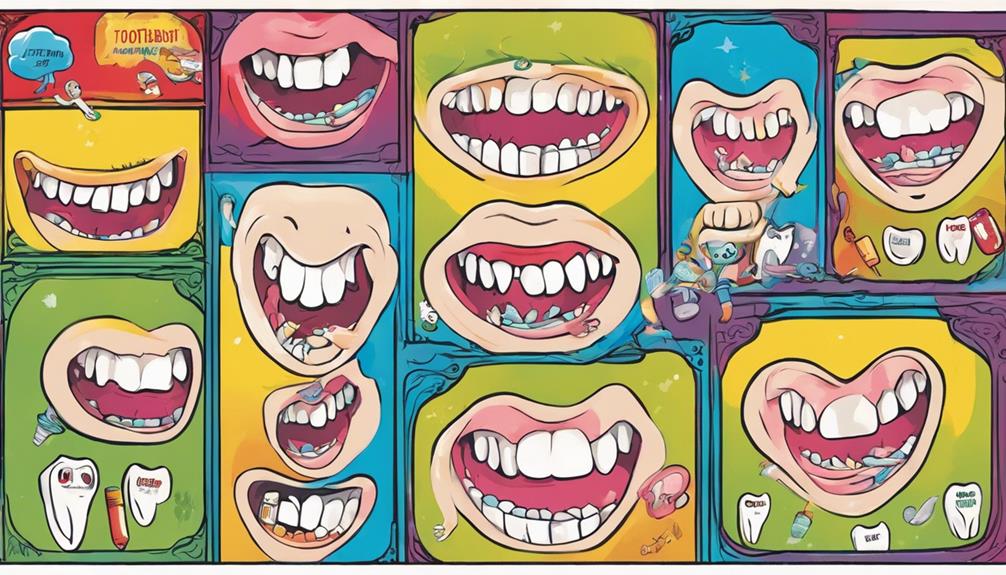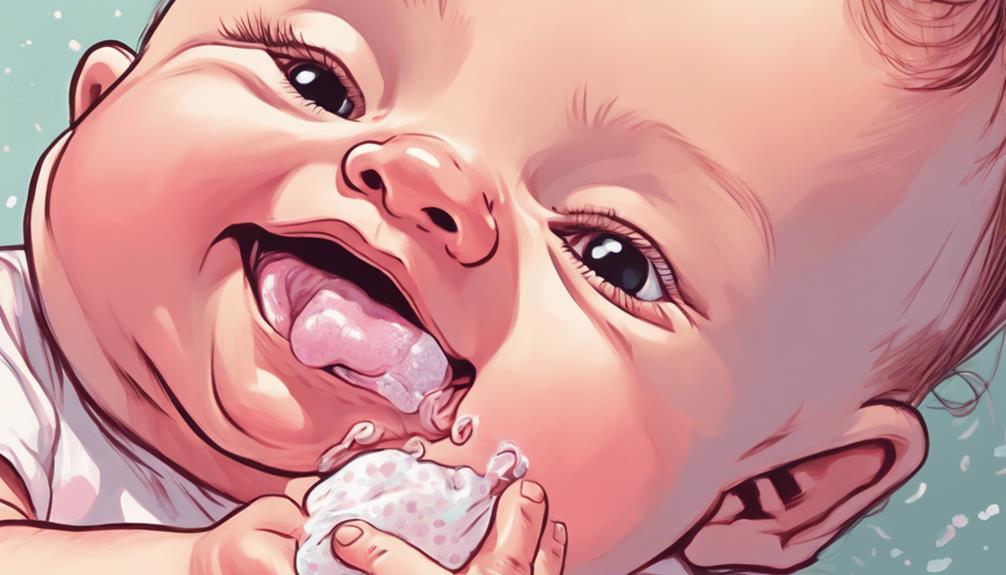To effectively navigate your baby's teething journey, a reliable baby teeth chart is essential. You'll find that teething usually starts between 4 to 12 months, with the lower central incisors being the first to emerge. By age 3, your child should have a complete set of 20 primary teeth. Various online resources, including printable PDFs and mobile apps, help track these milestones. Understanding the teething timeline, symptoms, and care options can greatly ease the process for both you and your baby. You'll discover even more valuable insights to support this important phase in your child's development.
Key Takeaways
- Printable PDF eruption charts are available online to visualize expected timelines for primary teeth emergence.
- Mobile apps can help log tooth eruption dates and track dental milestones effectively.
- Dental health websites offer comprehensive guides and articles on baby teeth development and care.
- Growth milestone trackers monitor overall development alongside dental milestones for better awareness.
Teething Timeline Overview
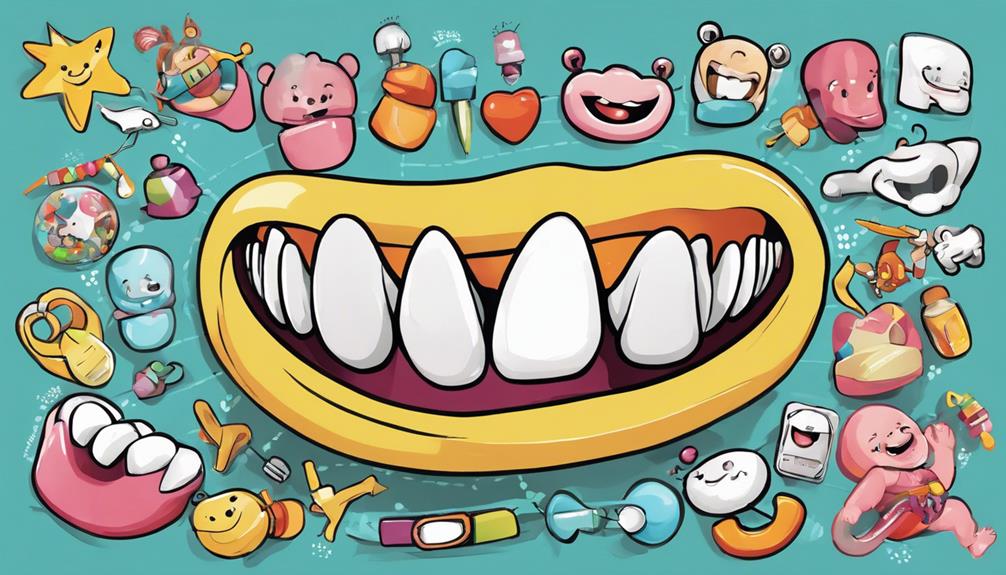
Teething typically begins around 4 to 12 months, with most kids seeing their first tooth emerge around 6 to 10 months. This initial milestone is usually the lower central incisors, marking the start of the teething timeline.
As you track your child's progress, referring to a baby teeth chart can help you anticipate when to expect those primary teeth. By age 3, your little one should have a complete set of 20 primary teeth, including 10 in the upper jaw and 10 in the lower jaw.
Individual timelines for tooth eruption can vary, so don't worry if your child's first baby tooth arrives a bit earlier or later. Some kids may begin teething as early as 3 months, while others mightn't get their first tooth until 12 months.
As teeth start to erupt, you may notice teething symptoms like drooling, fussiness, or a desire to chew on objects. Understanding this timeline is essential for planning dental care, ensuring you're ready for check-ups as your child grows.
Keeping an eye on the teething process helps you manage any discomfort and maintain your child's oral health effectively.
Order of Baby Teeth Eruption
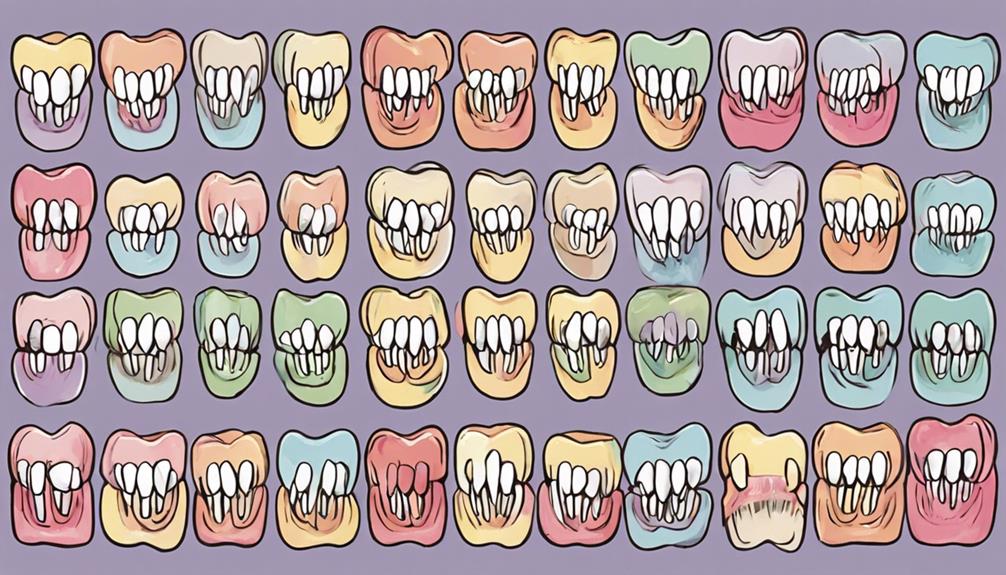
The order in which your child's baby teeth erupt follows a specific pattern, starting with the lower central incisors around 6 to 10 months. This is the first sign that your baby's teeth are on their way.
Next, you can expect the upper central incisors to come in between 8 to 12 months.
After the central incisors, the lateral incisors emerge. The upper lateral incisors typically erupt between 9 to 13 months, while the lower lateral incisors come in a bit later, around 10 to 16 months.
Following these, the upper first molars usually appear between 13 to 19 months, and the lower first molars erupt from 14 to 18 months.
Total Number of Baby Teeth
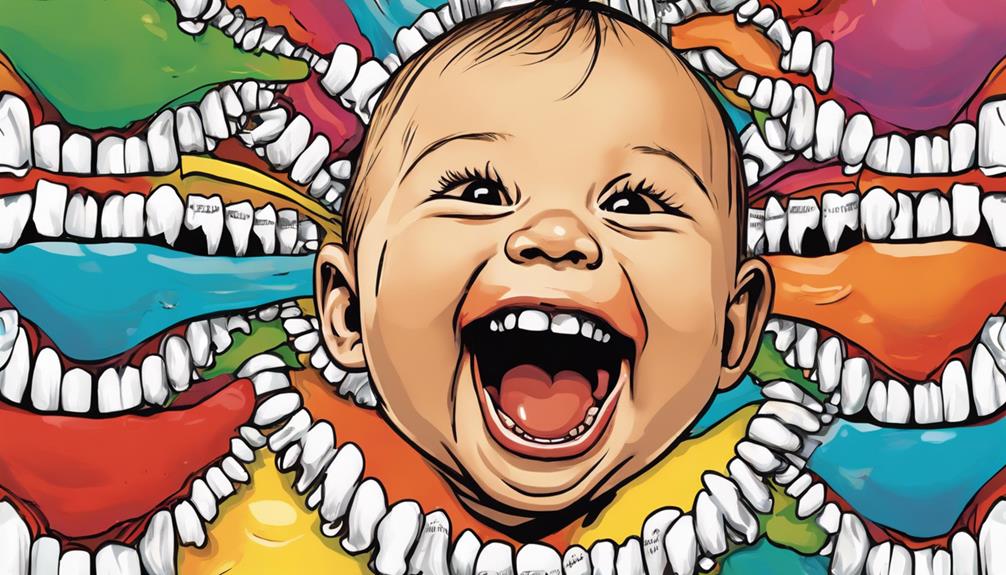
Babies typically have a set of 20 primary teeth that emerge over the first few years of life.
These baby teeth, also known as deciduous teeth, consist of 10 in the upper jaw and 10 in the lower jaw.
The teething process usually starts around 6 months of age, with the first teeth emerging in a specific order.
According to the teeth eruption chart, the lower central incisors are the first to appear, followed by the upper central incisors.
Next come the lateral incisors, then the first molars, and finally, the canines.
Common Teething Symptoms

Common symptoms you might notice during this phase include increased drooling, irritability, and swollen gums.
As your baby's teeth begin to emerge, you'll see these common teething symptoms manifesting. The excessive drooling may lead to a rash around their mouth or chin, making it essential to keep the area dry.
You might also notice your little one showing signs of irritability. They may become fussy, especially during the evening or at bedtime, as the discomfort can disrupt their sleep. Sleep disturbances, including difficulty falling asleep or staying asleep, are frequently reported during teething phases.
Additionally, babies often have a strong urge to bite and chew on objects to relieve the pressure in their gums.
While mild fever can occur, a high fever over 101°F isn't typical for teething and should be discussed with your healthcare provider.
Be mindful of non-teething symptoms like facial rashes, coughs, or diarrhea. These may indicate other health issues rather than teething.
Always consult your healthcare provider if you're unsure or if symptoms persist.
Managing Teething Discomfort
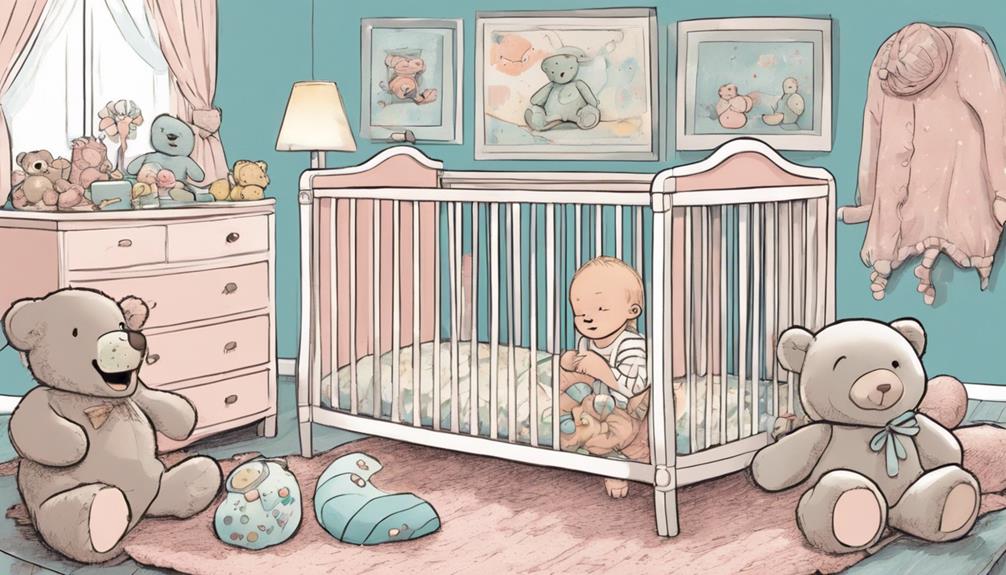
When your baby starts teething, you might notice symptoms like drooling and swollen gums.
It's important to know effective relief methods to help ease their discomfort.
Let's explore some strategies to keep your little one comfortable during this challenging time.
Common Teething Symptoms
Teething can bring about several discomforting symptoms, making it important for parents to recognize and manage them effectively. Understanding these common teething symptoms helps you support your baby during this challenging time. Here are three key signs to watch for:
- Swollen Gums: As teeth push through, you may notice your baby's gums becoming red and swollen. This can cause significant discomfort.
- Irritability: Your little one might be fussier than usual, as teething discomfort can affect their mood and overall temperament.
- Drooling: Increased drooling is a common symptom during teething phases, often leading to wet clothes and potential skin irritation.
You might also see changes in your baby's eating and sleeping habits. It's not unusual for them to experience reduced appetite for solid foods or have sleep disturbances during this time.
While mild fever can occur, keep an eye out for a high fever (over 101°F), as this may signal other health issues.
If you notice any non-teething symptoms such as a rash or persistent diarrhea, consult your healthcare provider for guidance.
Effective Relief Methods
To help soothe your baby's teething discomfort, several effective relief methods can provide comfort and ease their pain. Gentle gum massage can increase blood flow and help alleviate discomfort in their gums.
You might also try chilled teething rings; just refrigerate them (don't freeze) for a soothing, safe option for your little one to chew on.
If your baby experiences significant teething pain, consider using over-the-counter pain relievers like acetaminophen or ibuprofen, but always consult your pediatrician first, especially for children under 2.
Another simple method is applying a cold spoon gently to swollen gums, but do so with caution to avoid injury.
However, it's essential to follow the recommendations of the American Academy of Pediatrics, which advises against using topical numbing gels for teething due to serious risks, like methemoglobinemia linked to benzocaine products.
Tooth Loss Timeline

Around ages 6 to 7, you'll notice your child's primary teeth starting to fall out, beginning with the central incisors. This tooth loss is a normal part of child development, as these baby teeth make way for permanent teeth. Understanding the timeline can help you anticipate the changes.
Here's a quick overview of the tooth loss timeline:
- Central Incisors (Ages 6-7): The first teeth to go, marking the start of this exciting phase.
- Lateral Incisors (Ages 7-8): Following the central incisors, the lateral incisors will begin to loosen.
- Canines and Molars (Ages 9-12): These are usually lost later, making room for the larger permanent teeth.
As you reference eruption charts, you'll see how the loss of baby teeth aligns with the emergence of adult teeth.
By age 13, your child will likely have 28 permanent teeth, missing only the wisdom teeth, which typically appear later.
Tracking this tooth loss timeline guarantees you're prepared for your child's dental changes, starting from that very first tooth.
Importance of Early Dental Care
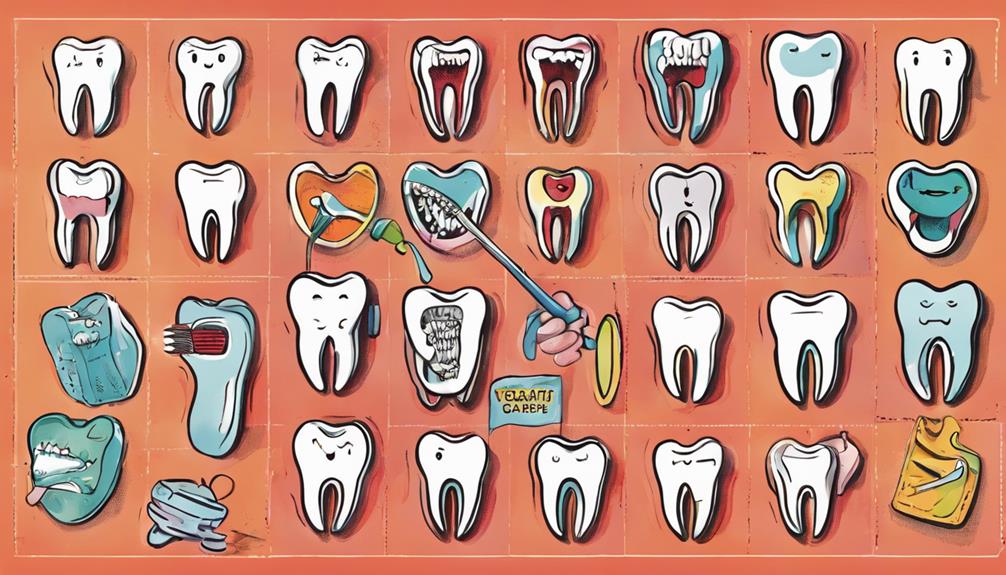
Understanding the timeline of tooth loss highlights the importance of early dental care in establishing strong oral hygiene habits right from the start. Scheduling your child's first dental visit by age 1 or when their first tooth erupts is vital. This proactive approach helps prevent dental decay and sets the stage for healthy development.
Awareness of teething milestones is essential. Here's a quick reference table that outlines key milestones in baby teeth eruption:
| Age (Months) | Teething Milestone | Importance |
|---|---|---|
| 6-12 | First tooth erupts | Start of early dental care |
| 1-2 | First dental visit | Establish oral hygiene habits |
| 3-6 | All baby teeth in place | Monitor for dental decay |
Role of Baby Teeth in Development

Baby teeth play an essential role in your child's development, aiding in chewing, speech, and the alignment of permanent teeth. These primary teeth are important for several reasons:
- Nutrition: Baby teeth help your child chew food properly, which is critical for getting the nutrients needed for growth.
- Speech Development: They assist in forming sounds and words, making them necessary for effective communication during early language acquisition.
- Dental Alignment: Baby teeth hold space in the jaw for permanent teeth, guiding their eruption and reducing the risk of dental misalignment in the future.
Typically, your child's first tooth will emerge around 6 months, with all 20 primary teeth usually in place by age 2.5 to 3 years. This marks significant milestones in child development.
Maintaining the health of baby teeth is important for overall oral health. Early dental care can prevent complications like cavities and infections that could affect their permanent teeth.
Cultural Approaches to Teething
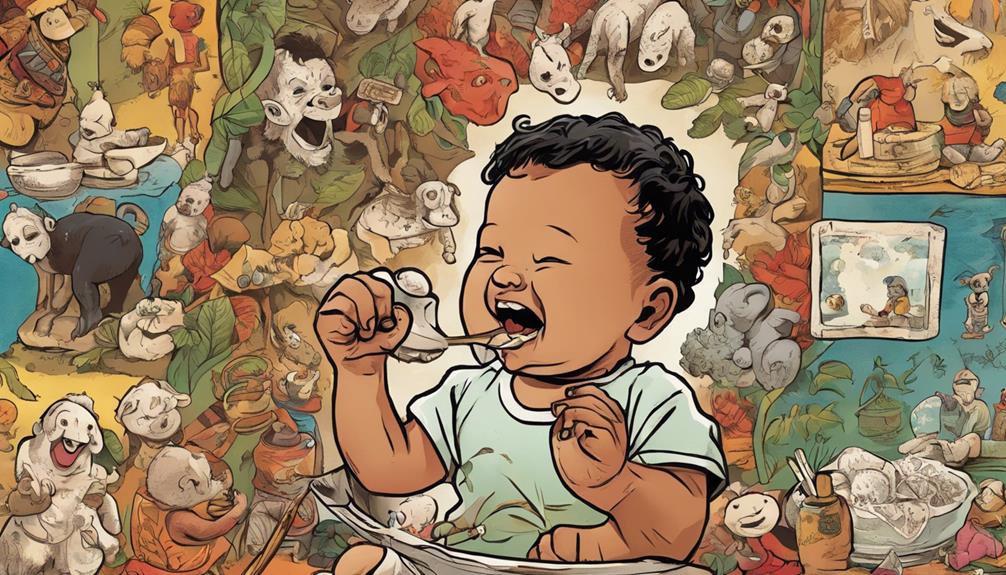
Different cultures have unique and meaningful ways to celebrate and support children through the teething process. These cultural practices often include various methods to ease teething discomfort and mark this important milestone.
Here's a quick overview of some common cultural approaches:
| Cultural Practice | Description | Parenting Strategy |
|---|---|---|
| Tooth Parties | Celebrations to honor the arrival of a tooth | Create a joyful atmosphere for the child |
| Herbal Remedies | Traditional medicines used to soothe discomfort | Explore natural options for relief |
| Teething Necklaces | Necklaces made from natural materials believed to help | Consider safe, monitored use |
| Rituals and Ceremonies | Special events to commemorate teething milestones | Involve family and community in support |
| Local Beliefs | Unique methods based on cultural beliefs | Learn about and respect diverse practices |
Resources for Tracking Eruption
Eruption charts serve as valuable tools for parents to easily track their child's dental development milestones. As you navigate the journey of your baby's teething process, these charts help you anticipate when your little one will start showing those adorable primary teeth. Typically, babies start teething around six months, with lower central incisors emerging first.
Consider these resources for tracking tooth development:
- Printable PDF Eruption Charts: Easily accessible online, these charts provide a clear visual of the expected timeline for primary teeth.
- Mobile Apps: Many apps allow you to log tooth eruption dates, ensuring you never miss a milestone.
- Dental Health Websites: These sites offer detailed guides and articles on oral health, helping you understand when to seek dental care.
Frequently Asked Questions
Which Teeth Are Most Difficult for Babies?
The most difficult teeth for babies are typically the molars and canines. Their larger size and pointed structure can cause significant discomfort, leading to increased irritability as they push through the gums during eruption.
What Are the Worst Teeth for Teething?
Teething can feel like a storm brewing; the worst teeth for your baby are the molars. Their larger size causes significant discomfort, often leading to irritability and sleepless nights during eruption. Canines also add to the pain.
In What Order Should Baby Teeth Come Out?
When your child's baby teeth start to come out, expect the lower central incisors first, followed by the upper central incisors. Canines and molars will follow, usually between ages 9 to 12.
At What Age Do Babies Get Teeth Chart?
Isn't it amazing how quickly babies grow? Typically, you'll notice your little one's first teeth erupt around 4 to 12 months, starting with those cute lower central incisors. Enjoy each milestone along the way!
How Can I Use the Baby Teeth Chart to Track My Child’s Tooth Loss?
The baby teeth chart is a useful tool for tracking your child’s tooth loss. By understanding why baby teeth fall out according to the chart, you can monitor the normal progression of your child’s dental development. This can help identify any potential issues and ensure a healthy transition to permanent teeth. Understanding baby teeth and their natural shedding process can also help parents alleviate any fear or anxiety their child may have about losing their teeth. By using the baby teeth chart as a guide, parents can reassure their children that losing their baby teeth is a normal and important part of growing up. Additionally, by understanding baby teeth and their timeline for falling out, parents can better prepare for the arrival of their child’s permanent teeth and the potential need for orthodontic treatment in the future.
How Does Understanding Baby Teeth Roots Help in Using a Baby Teeth Chart?
Understanding why baby teeth root structure is essential in utilizing a baby teeth chart. The roots of baby teeth determine the sequence of tooth eruption and timing for when they will fall out. By knowing the root structure, parents and dentists can accurately track the growth and development of a child’s teeth.
Conclusion
In summary, understanding your baby's teething journey is essential, much like steering through the trials of a hero's quest.
By tracking the eruption of those precious baby teeth and managing discomfort, you're not just ensuring their comfort; you're laying the foundation for a healthy smile.
Embrace the wisdom of early dental care, and remember, every tooth is a stepping stone in your child's development, guiding them toward a bright future.
